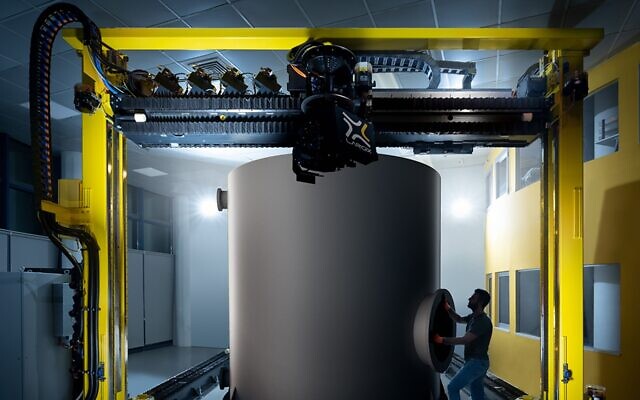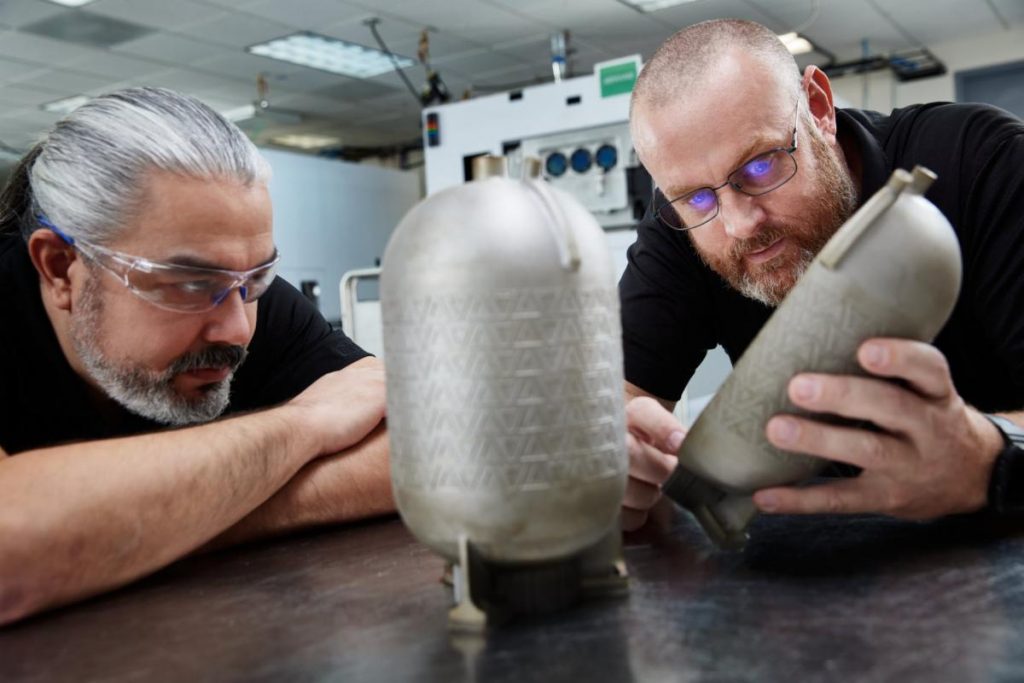Belgian chemical processing firm, the CGK Group, is planning to 3D print an entire 13-foot storage container according to a report by the Times of Israel.
By adopting Largix’s robotic, machine learning-assisted platform to construct the storage tank rather than traditional manual processes, the CGK Group anticipates being able to create it in a continuous cycle that effectively halves its overall cost.
“Nowadays, we produce our made-to-measure vessels out of semi-finished products,” the CGK Group’s CEO Tijl Charle told the Times of Israel. “This needs a lot of manual labor, next to a significant amount of scrap material. [Adopting] the platform will reduce our dependency on labor, increase our productivity and bring new opportunities in terms of shapes and new materials.”
“This will be a game-changer for us. Nobody else [in our industry] is using such technology. We estimate it will save us up to 50% in costs.”
A ‘Cold 3D Printing’ approach
Co-founded by Ronen Orr and Amir Sheelo in the Israeli town of Kokhav Ya’ir, Largix specializes in the development of robotic 3D printers, designed to engage in what it calls “real production processes.” With this industrial-scale goal in mind, the firm has come up with a large-format production platform, powered by an autonomous deposition technology that it has nicknamed ‘Cold 3D Printing.’
In practice, the system, which is capable of erecting builds up to 350 cm x 300 cm in size, deposits materials via a series of nozzles mounted to a moving robotic arm. Interestingly though, while doing so, the firm says its platform is capable of using sensor data, as well as machine learning, to ensure that objects produced feature the required bonding and welding strength to meet targeted industry standards.
Adding to its industrial credentials, Largix says that its machine is also compatible with polypropylene and polyethylene, polymers other large-format systems can struggle to print, and this combined with the unit’s automated nature, could make it uniquely well-suited to the needs of those manufacturers trapped in semi-automatic or manual workflows.
“We have more than 20 years’ background in traditional industries, making traditional products,” explains Orr. “[Drawing on this], we decided to develop a 3D printing technology that would be able to industrially produce real products reinventing traditional, labor-intensive, design and production of custom-made products made of polymers and composite materials, across diversified industries.”

CGK’s container 3D printing plans
Given the large-format 3D printing capabilities of their system, Orr and Sheelo have primarily marketed it as a means of creating polymeric tanks, the likes of which are used heavily in the food, chemical, and cosmetic sectors. In fact, in this application, the duo say that adopters could stand to cut their lead times in half and make their workflow 15 times more productive, all while building fully-customized containers.
Seeing the potential of Largix’s technology in this area, the CGK Group first invested in the company in 2019, and it’s now seeking to deploy the process itself within its chemical tank production. Having ordered one of the machines, the firm expects to be able to replace the laborious process it currently employs to hand-build containers, while using its automation features to manufacture “25 hours a day.”
From Largix’s perspective, Orr says that the CGK Group’s adoption of its technology proves that it has the scale, cost, and material efficacy needed to address large-scale applications, ahead of its planned commercial launch later this year.
“Our next addressable market will be even larger – building and infrastructure construction,” adds Orr. “Most custom-made construction is today done manually. We are already engaging with industry leaders to design solutions, based on our proprietary technology, that will deliver major innovation to the construction industry.”

Largix’s polymeric world-first?
On the face of it, Largix’s claims to have developed the “first 3D printer able to produce large industrial storage tanks” in plastic appears to hold water, as the closest thing to storage containers that additive manufacturing is used to produce regularly are metal fuel tanks, which are built for entirely different applications.
The likes of Lockheed Martin, for instance, have deployed 3D printing in this way for years, with use cases going as far back as 2014, when it worked with Stratasys Direct to additive manufacture a 15-foot fuel tank prototype. Designed to address satellite form, fit and function validation applications, the part was said to help Lockheed Martin get its products to market at almost half the time and cost.
More recently, in August 2019, researchers at the University of Strathclyde and Airbus Defence and Space also launched an investigation into the feasibility of 3D printing fuel tanks. During the project, the organizations worked with TWI in an attempt to determine which method would be best suited to producing the tanks cost-competitively, in a way that allowed their manufacture to be reshored in the UK.
To stay up to date with the latest 3D printing news, don’t forget to subscribe to the 3D Printing Industry newsletter or follow us on Twitter or liking our page on Facebook.
For a deeper dive into additive manufacturing, you can now subscribe to our Youtube channel, featuring discussion, debriefs, and shots of 3D printing in-action.
Are you looking for a job in the additive manufacturing industry? Visit 3D Printing Jobs for a selection of roles in the industry.
Featured image shows an engineer overseeing the Largix 3D printing of a container. Image via the Times of Israel, Largix.


